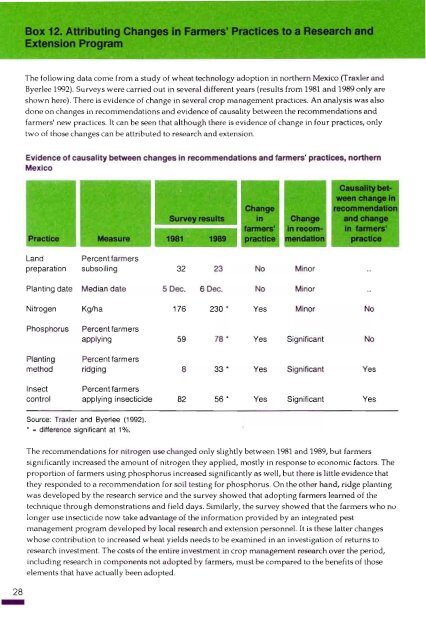The Adoption of Agricultural Technology - Food Security Group
The Adoption of Agricultural Technology - Food Security Group
The Adoption of Agricultural Technology - Food Security Group
You also want an ePaper? Increase the reach of your titles
YUMPU automatically turns print PDFs into web optimized ePapers that Google loves.
<strong>The</strong> following data come from a study <strong>of</strong> wheat technology adoption in northern Mexico (Traxler andByerlee 1992). Surveys were carried out in several different years (results from 1981 and 1989 only areshown here). <strong>The</strong>re is evidence <strong>of</strong> change in several crop management practices. An analysiS was alsodone on changes in recommendations and evidence <strong>of</strong> causality between the recommendations andfarmers' new practices. It can be seen that although there is evidence <strong>of</strong> change in four practices, onlytwo <strong>of</strong> those changes can be attributed to research and extension.Evidence <strong>of</strong> causality between changes in recommendations and farmers' practices, northernMexicoPr8ctlceLand Percent farmerspreparation subsoiling 32 23 No MinorPlanting date Median date 5 Dec. 6 Dec. No MinorNitrogen Kg/ha 176 230 • Yes Minor NoPhosphorusPercent farmersapplying 59 78 • Yes Significant NoPlanting Percent farmersmethod ridging 8 33 • Yes Significant YesInsect Percent farmerscontrol applying insecticide 82 56 • Yes Significant YesSource: Traxler and Byerlee (1992) .• = difference significant at 1%.<strong>The</strong> recommendations for nitrogen use changed only slightly between 1981 and 1989, but farmerssignificantly increased the amount <strong>of</strong> nitrogen they applied, mostly in response to economic factors. <strong>The</strong>proportion <strong>of</strong> farmers using phosphorus increased significantly as well, but there is little evidence thatthey responded to a recommendation for soil testing for phosphorus. On the other hand, ridge plantingwas developed by the research service and the survey showed that adopting farmers learned <strong>of</strong> thetechnique through demonstrations and field days. Similarly, the survey showed that the farmers who nolonger use insecticide now take advantage <strong>of</strong> the information prOVided by an integrated pestmanagement program developed by local research and extension personnel. It is these latter changeswhose contribution to increased wheat yields needs to be examined in an investigation <strong>of</strong> returns toresearch investment. <strong>The</strong> costs <strong>of</strong> the entire investment in crop management research over the period,including research in components not adopted by farmers, must be compared to the benefits <strong>of</strong> those-elements that have actually been adopted.28



